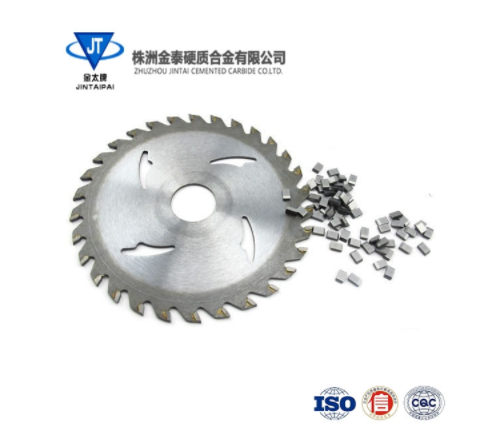Carbide saw blades include most parameters such as tooth shape, angle, number of teeth, saw blade thickness, saw blade diameter, carbide type, etc. These parameters determine the saw blade’s processing capabilities and cutting performance.
Tooth shape, common tooth shapes include flat teeth, trapezoidal teeth, trapezoidal teeth, inverted trapezoidal teeth, etc. Flat teeth are widely used and are mainly used for sawing ordinary wood. This tooth shape is relatively simple and the saw edge is rough. During the grooving process, the flat teeth can make the groove bottom flat. The better quality is the razor-tooth saw blade, which is suitable for sawing all kinds of artificial boards and veneer panels. Trapezoidal teeth are suitable for sawing veneer panels and fireproof boards, and can achieve higher sawing quality. Inverted trapezoidal teeth are commonly used in undergroove saw blades.
The position of the carbide saw blade during cutting is the angle of the saw teeth, which affects the cutting performance. The rake angle γ, relief angle α, and wedge angle β have a great influence on cutting. The rake angle γ is the cutting angle of the saw teeth. The larger the rake angle, the faster the cutting. The rake angle is generally between 10-15°. The relief angle is the angle between the saw teeth and the processed surface. Its function is to prevent friction between the saw teeth and the processed surface. The larger the relief angle, the smaller the friction and the smoother the processed product. The clearance angle of carbide saw blades is generally 15°. Wedge angle is derived from rake angle and back angle. However, the wedge angle cannot be too small. It plays a role in maintaining the strength, heat dissipation and durability of the tooth. The sum of rake angle γ, back angle α and wedge angle β is equal to 90°.
The number of teeth of a saw blade. Generally speaking, the more teeth there are, the more cutting edges can be cut per unit time and the better the cutting performance. However, if the number of cutting teeth is large, a large amount of cemented carbide is required, and the price of the saw blade will be high. However, if the saw teeth are too large, If the saw teeth are dense, the chip capacity between the teeth becomes smaller, which can easily cause the saw blade to heat up; but if there are too many saw teeth and the feed rate is not properly matched, the amount of cutting per tooth will be very small, which will intensify the friction between the cutting edge and the workpiece, and the use of the blade will Lifespan will be affected. Usually the tooth spacing is 15-25mm, and a reasonable number of teeth should be selected according to the material being sawed.
Theoretically, we definitely want the saw blade to be as thin as possible, but in fact sawing is a waste. The material to be sawed with a carbide saw blade and the process used to make the blade determine the thickness of the saw blade. Kimbers recommends that when choosing the thickness of the saw blade, you should consider the stability of the saw blade and the material being cut.
The diameter of the saw blade is related to the sawing equipment used and the thickness of the sawed workpiece. The diameter of the saw blade is small, and the cutting speed is relatively low; the diameter of the saw blade is high, which requires high requirements on the saw blade and sawing equipment, and the sawing efficiency is also high.
A series of parameters such as tooth shape, angle, number of teeth, thickness, diameter, carbide type, etc. are combined into the entire carbide saw blade. Only by reasonable selection and matching can you better utilize its advantages.
Post time: Sep-24-2024













